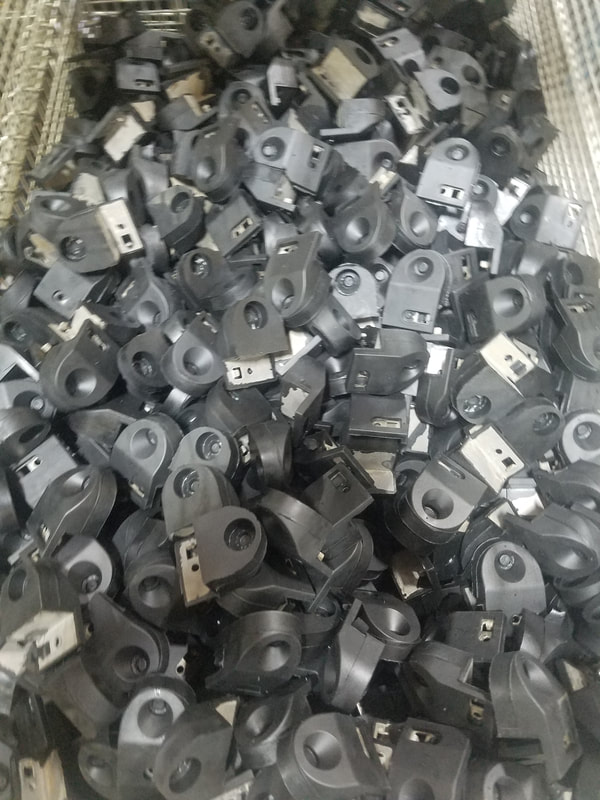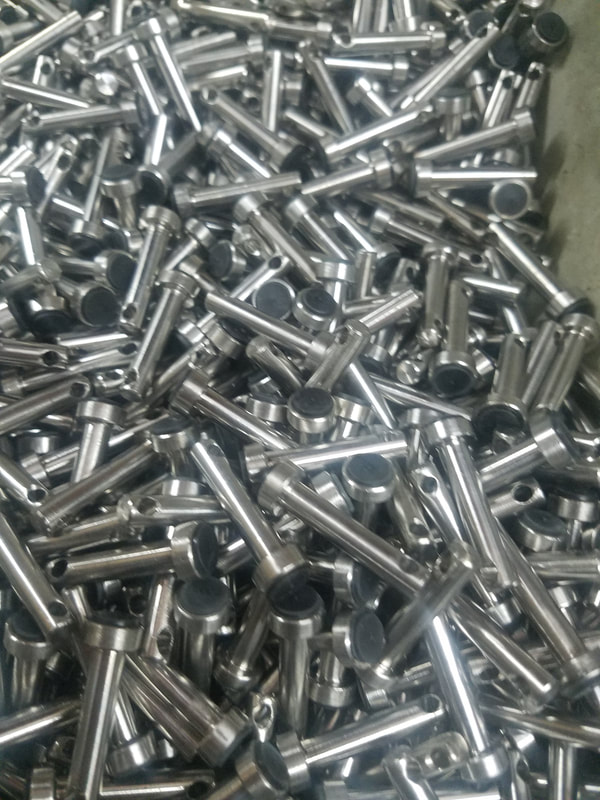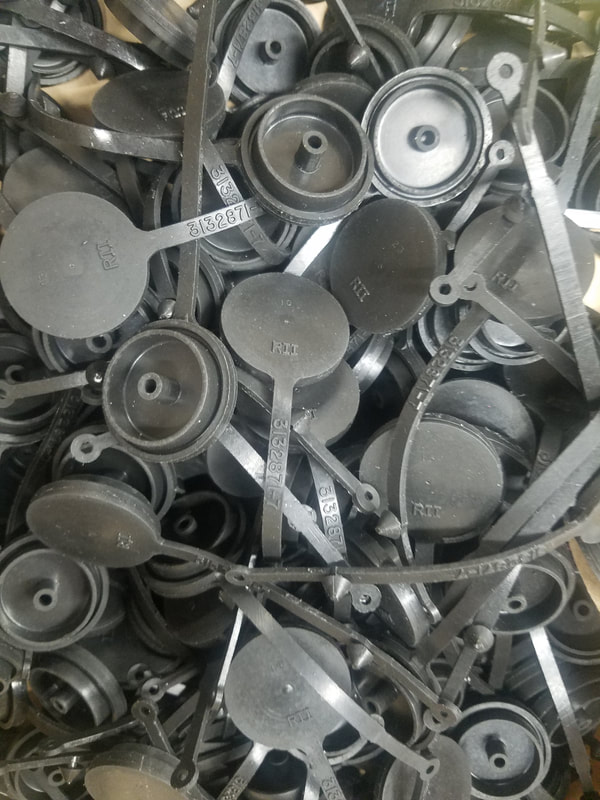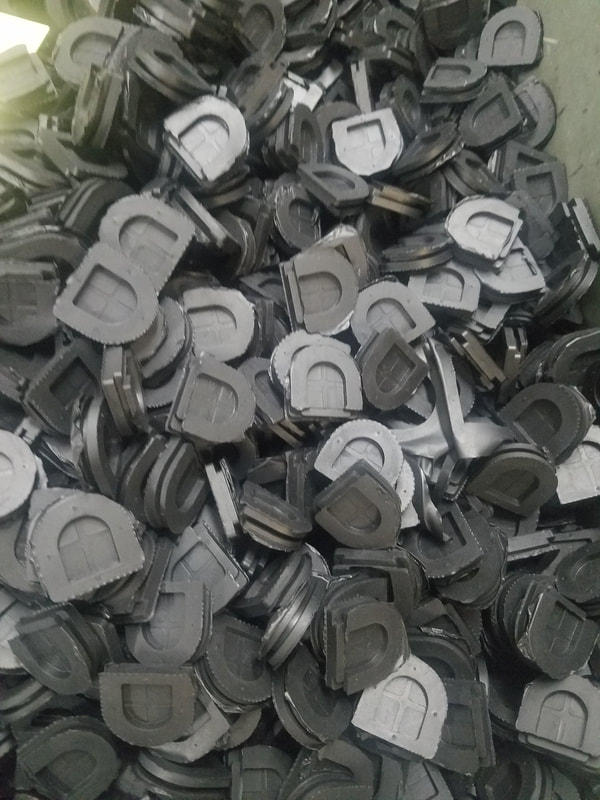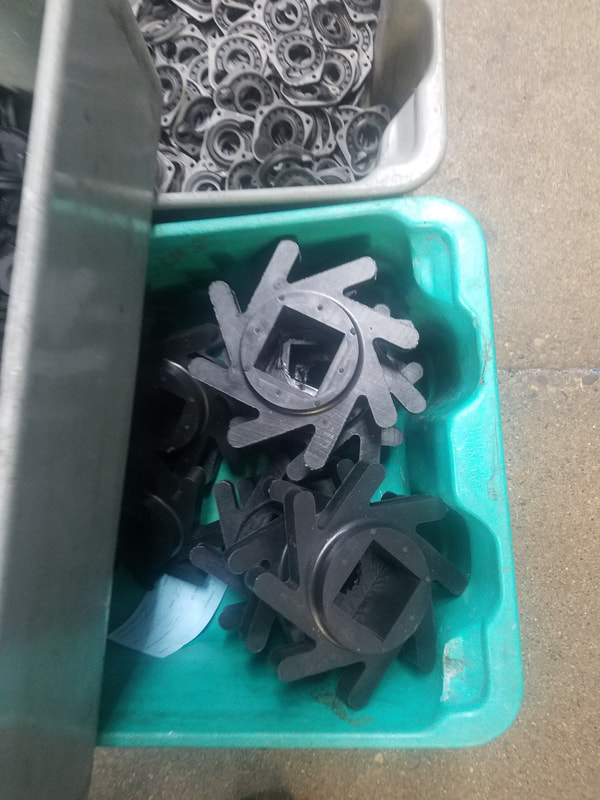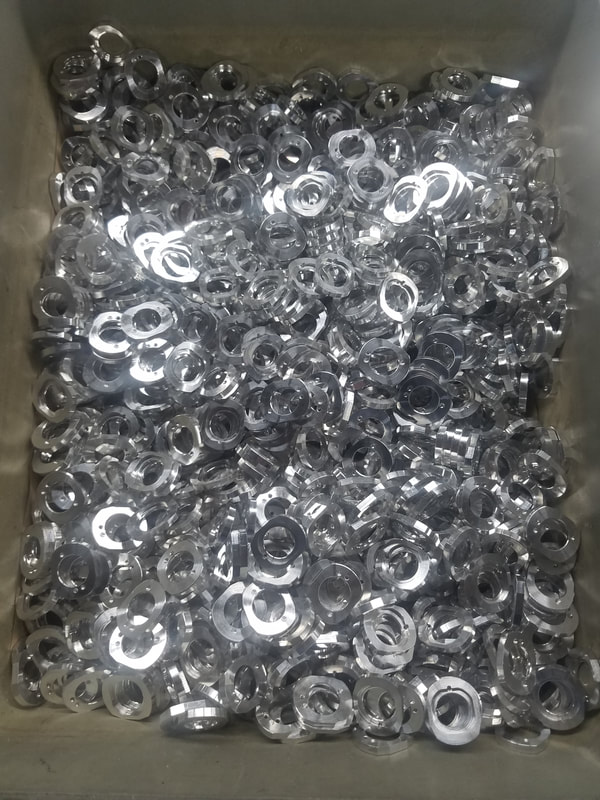Phone: 952-445-1320
IMPORTANT UPDATE:
Rubber Industries is designated as an essential manufacturer due to our Medical and Department of Defense manufacturing.
We continue to operate all aspects of our tooling and manufacturing 24x7x365
Neoprene Custom Molded Parts
Phone: 952-445-1320
Why Choose Us for Your Custom Neoprene Molding Needs?
- 50 years of technical expertise working with the custom molding of elastomers like neoprene
- Same ownership in our 50 years leads to consistency in quality, delivery, and pricing
- Fastest custom tooling, in house, for prototype and production tooling
- Rubber Industries operates 24/7 every day of the year to build tooling and fulfill custom molded parts as fast as possible
- Here in our Minneapolis area plant, we work in-house to keep custom tooling and custom molding running fast.
- We have quick high volume capability with injection molding.
- We know how to create neoprene bonded items, such as neoprene to metal bonded, polychloroprene to metal bonded, and neoprene overmolded to various substrates.
- Rubber Industries, Inc uses our many capabilities to get large quantities of custom molded parts to you fast and economically.
- We have multiple modern injection presses to meet your specific project along with our many presses to do transfer and compression molding
- We make 100's of custom tools per year to make the all of our custom molded parts for elastomers including neoprene
- We are willing to accept either low volume or high volume orders. Our varied press sizes support all types of projects
- We've invested millions in equipment in just these last 4 years to support our capabilities to offer you the fastest custom tooling, prototyping, and custom molded production
|
|
Neoprene, also known as polychloroprene and PC-rubber, is an excellent choice for use in demanding environments. It has great chemical stability and can maintain flexibility over a wide range of temperatures.
We have molded millions of neoprene parts of all shapes, sizes, and overmolded on many substrates.
Our 50 years of experience will help ensure we provide the best possible quality, delivery, and pricing for you project while meeting your timelines. All from one custom molder and toolmaker.... so we manage the entire project for you without having to work with multiple vendors, toolmakers, molders, material suppliers, and in different languages.
Combined with other materials is used in fire resistant applications. This material has more resistance to degradation than natural rubber and some other synthetic rubbers, which is another reason why it's often used in demanding environments.
We have molded millions of neoprene parts of all shapes, sizes, and overmolded on many substrates.
Our 50 years of experience will help ensure we provide the best possible quality, delivery, and pricing for you project while meeting your timelines. All from one custom molder and toolmaker.... so we manage the entire project for you without having to work with multiple vendors, toolmakers, molders, material suppliers, and in different languages.
Combined with other materials is used in fire resistant applications. This material has more resistance to degradation than natural rubber and some other synthetic rubbers, which is another reason why it's often used in demanding environments.
Rapid Prototyping
Committed to speed, we offer rapid prototyping services to help you bring your product idea to market as fast as possible.
We are the fastest rapid prototyping of elastomers like neoprene, and we bring these custom molded neoprene parts to market faster than anyone else.
Whether you're in the industrial, automotive, consumer, or medical industry, our experts can help.
Custom Tooling
Rubber Industries, Inc offers the fastest tooling services to create the molds you need for your project. Some companies create their tools out of aluminum, but we use steel because steel tooling is the most cost effective in the long-run. Steel tools last longer, letting you get more items out of the mold without having to pay for more tooling.
Our steel custom tooling is also less expensive than others' temporary aluminum tooling. Components made of these molds are of higher quality as well. We can make tools within 1-15 days, depending on complexity. Our company aims to be the fastest from design to shipping you parts, and it shows in how we operate our business.
We stay open 24 x 7 x 365, and we keep all production and tooling running every day of the year.
Committed to speed, we offer rapid prototyping services to help you bring your product idea to market as fast as possible.
We are the fastest rapid prototyping of elastomers like neoprene, and we bring these custom molded neoprene parts to market faster than anyone else.
Whether you're in the industrial, automotive, consumer, or medical industry, our experts can help.
Custom Tooling
Rubber Industries, Inc offers the fastest tooling services to create the molds you need for your project. Some companies create their tools out of aluminum, but we use steel because steel tooling is the most cost effective in the long-run. Steel tools last longer, letting you get more items out of the mold without having to pay for more tooling.
Our steel custom tooling is also less expensive than others' temporary aluminum tooling. Components made of these molds are of higher quality as well. We can make tools within 1-15 days, depending on complexity. Our company aims to be the fastest from design to shipping you parts, and it shows in how we operate our business.
We stay open 24 x 7 x 365, and we keep all production and tooling running every day of the year.
Overmolding
We are also experienced in creating overmolded items. Overmolding can be used for product reinforcement and creating a soft grip around another material. An overmolded item consists of two or more materials layered over each other. In order to create this type of product, we need to run several interdependent processes.
Custom Injection Molding
You have quick high volume capability with injection molding when you place large orders of components. For medium to high precision components, it's the fastest method to get large quantities of parts fast and economically. One reason why production is fast with custom injection molding is it doesn't use pre-forms or pre-form operating equipment. Our company offers faster high volume injection molding than other companies because we operate entirely in-house 24 x 7 x 365, our modern equipment can hold up to 15 lbs of material, and we have multiple modern injection presses to meet your specific project needs.
Transfer Molding
Another option for fast production of rubber components is transfer elastomer molding. If custom colors are important in your prototype, we may recommend this molding method for you. It helps prevent custom colors from mixing with other colors or becoming contaminated because the molds remain securely closed without material leaking out of them. Like injection molding, this type of molding works well for large orders of medium to high precision components.
Compression Molding
This type of elastomer molding is great for producing high-strength custom molded components. As with all of our molding processes, we accept both high volume and low volume production orders. In addition to high-strength components, this molding method is recommended for medium precision components, simple designs, and low volume production.
If you're unsure of which process is best for your prototype, one of our experts can help you determine which is most economical based on your needs. Although high volume injection molding is popular, it's not always the best choice. A prototype's intended characteristics influence what type of molding is best.
Bonding
Prototypes that require rubber attached to metal may need to undergo the bonding process in order to create a secure attachment between the two materials. We have created many bonded components, including nitrile NBR to metal bonded, SBR to metal bonded, hydrogenated NBR to metal bonded, and neoprene to metal bonded.
We are also experienced in creating overmolded items. Overmolding can be used for product reinforcement and creating a soft grip around another material. An overmolded item consists of two or more materials layered over each other. In order to create this type of product, we need to run several interdependent processes.
Custom Injection Molding
You have quick high volume capability with injection molding when you place large orders of components. For medium to high precision components, it's the fastest method to get large quantities of parts fast and economically. One reason why production is fast with custom injection molding is it doesn't use pre-forms or pre-form operating equipment. Our company offers faster high volume injection molding than other companies because we operate entirely in-house 24 x 7 x 365, our modern equipment can hold up to 15 lbs of material, and we have multiple modern injection presses to meet your specific project needs.
Transfer Molding
Another option for fast production of rubber components is transfer elastomer molding. If custom colors are important in your prototype, we may recommend this molding method for you. It helps prevent custom colors from mixing with other colors or becoming contaminated because the molds remain securely closed without material leaking out of them. Like injection molding, this type of molding works well for large orders of medium to high precision components.
Compression Molding
This type of elastomer molding is great for producing high-strength custom molded components. As with all of our molding processes, we accept both high volume and low volume production orders. In addition to high-strength components, this molding method is recommended for medium precision components, simple designs, and low volume production.
If you're unsure of which process is best for your prototype, one of our experts can help you determine which is most economical based on your needs. Although high volume injection molding is popular, it's not always the best choice. A prototype's intended characteristics influence what type of molding is best.
Bonding
Prototypes that require rubber attached to metal may need to undergo the bonding process in order to create a secure attachment between the two materials. We have created many bonded components, including nitrile NBR to metal bonded, SBR to metal bonded, hydrogenated NBR to metal bonded, and neoprene to metal bonded.
|
|
Products Commonly Made with Neoprene
Examples of products that can be made with this material include:
Common components made of this material are:
As you can tell, this material can be used in a wide variety of industries, including the consumer, automotive, industrial, medical, and defense contracting industries. We serve all of these industries and more.
Custom elastomer molding services we offer include injection molding, transfer molding, compression molding, bonding, overmolding, tooling, and rapid prototyping. Our company also has the skill to create fabric reinforced items.
Examples of products that can be made with this material include:
- Laptop sleeves
- Dry suits
- Orthopaedic braces
- Fan belts
- Electrical insulation
- Marine impellers
Common components made of this material are:
- Seals
- Gaskets
- O-rings
- Grommets
- Hoses
- Diaphragms
- Bellows
As you can tell, this material can be used in a wide variety of industries, including the consumer, automotive, industrial, medical, and defense contracting industries. We serve all of these industries and more.
Custom elastomer molding services we offer include injection molding, transfer molding, compression molding, bonding, overmolding, tooling, and rapid prototyping. Our company also has the skill to create fabric reinforced items.
If you ever need other parts or items made of a material besides PC-rubber, we are likely to be able to fulfill the order. Other elastomers rubber we work with include:
Neoprene combined with other materials is used in fire resistant applications because the material has fire retardant properties. We can make other elastomer blends besides this when necessary to make sure your product gets the exact characteristics you need. Nitrile NBR, for instance, is commonly blended with other elastomers because it has resistance to oils, fuels, and chemicals.
Common Parts
Typical custom molded parts our clients need include seals, gaskets, o-rings, diaphragms, and bellows. We can have these components shipped to you within 1-10 days in whatever elastomer you need that we work with. If you don't see your desired material listed, you can give us a call and we'll let you know if we use that material.
- Nitrile NBR
- EPDM
- SBR
- HNBR
- FKM
- Viton
- Silicone
Neoprene combined with other materials is used in fire resistant applications because the material has fire retardant properties. We can make other elastomer blends besides this when necessary to make sure your product gets the exact characteristics you need. Nitrile NBR, for instance, is commonly blended with other elastomers because it has resistance to oils, fuels, and chemicals.
Common Parts
Typical custom molded parts our clients need include seals, gaskets, o-rings, diaphragms, and bellows. We can have these components shipped to you within 1-10 days in whatever elastomer you need that we work with. If you don't see your desired material listed, you can give us a call and we'll let you know if we use that material.
Neoprene Elastomer Molding Services
Neoprene, which is also known as pc-rubber and polychloroprene, was the first synthetic rubber to be produced and sold successfully and remains extremely popular today. More than 300,000 tons of neo-prene is produced each year, and that figure is expected to surpass 400,000 tons within the next few years.
The substance is in such high demand because it offers the benefits of natural rubber without many or its drawbacks. Neop-rene resists heat, chemicals, fat and oil, and it can also endure exposure to ozone and ultraviolet light without losing its elastic properties. The substance is also synthetic, which means that it contains no latex and is suitable for medical applications. Neo-prene is a long-chain molecule composed mainly of hydrogen and carbon atoms. It is formed by linking together smaller molecules known as monomers.
The Development of the First Synthetic Rubber
Scientists began looking for synthetic alternatives to natural rubber in earnest during the early nineteenth century. The discovery of the vulcanization process by Charles Goodyear in 1839 had revolutionized the rubber industry and created many new markets for the product, but the latex used to make rubber was a finite resource and almost all of it was located in Southeast Asia.
Efforts to develop a synthetic alternative to natural rubber were largely unsuccessful for about a century, but that changed in 1930 when a DuPont scientist attended a lecture at Notre Dame University. The scientist watched as a jelly turned into a substance that behaved very much like rubber after being exposed to sulfur, and what he witnessed was enough to convince him to pursue the patent rights and conduct further research.
DuPont spent a year developing the substance, which was originally sold under the DuPrene brand name. However, initial sales were disappointing because the product emitted a foul odor and was prohibitively expensive to produce. These obstacles were eventually overcome, and the substance went on to play a crucial role during World War II. DuPont encouraged manufacturers and consumers to give DuPrene a try by publishing a technical journal containing research articles about the substance that gave manufacturers using it a place to advertise their goods.
Neoprene, which is also known as pc-rubber and polychloroprene, was the first synthetic rubber to be produced and sold successfully and remains extremely popular today. More than 300,000 tons of neo-prene is produced each year, and that figure is expected to surpass 400,000 tons within the next few years.
The substance is in such high demand because it offers the benefits of natural rubber without many or its drawbacks. Neop-rene resists heat, chemicals, fat and oil, and it can also endure exposure to ozone and ultraviolet light without losing its elastic properties. The substance is also synthetic, which means that it contains no latex and is suitable for medical applications. Neo-prene is a long-chain molecule composed mainly of hydrogen and carbon atoms. It is formed by linking together smaller molecules known as monomers.
The Development of the First Synthetic Rubber
Scientists began looking for synthetic alternatives to natural rubber in earnest during the early nineteenth century. The discovery of the vulcanization process by Charles Goodyear in 1839 had revolutionized the rubber industry and created many new markets for the product, but the latex used to make rubber was a finite resource and almost all of it was located in Southeast Asia.
Efforts to develop a synthetic alternative to natural rubber were largely unsuccessful for about a century, but that changed in 1930 when a DuPont scientist attended a lecture at Notre Dame University. The scientist watched as a jelly turned into a substance that behaved very much like rubber after being exposed to sulfur, and what he witnessed was enough to convince him to pursue the patent rights and conduct further research.
DuPont spent a year developing the substance, which was originally sold under the DuPrene brand name. However, initial sales were disappointing because the product emitted a foul odor and was prohibitively expensive to produce. These obstacles were eventually overcome, and the substance went on to play a crucial role during World War II. DuPont encouraged manufacturers and consumers to give DuPrene a try by publishing a technical journal containing research articles about the substance that gave manufacturers using it a place to advertise their goods.
The Advantages of Using Neoprene
Natural rubber has high tensile strength and resists cutting and tearing, but it is not very durable and degrades when exposed to sunlight for long periods. Neo-prene was developed to overcome these issues and provide additional benefits. The advantages of neo-prene include:
Natural rubber has high tensile strength and resists cutting and tearing, but it is not very durable and degrades when exposed to sunlight for long periods. Neo-prene was developed to overcome these issues and provide additional benefits. The advantages of neo-prene include:
- It’s tough and durable: One of the chief reasons that neo-prene is such a popular synthetic rubber is its superior physical toughness. The substance shrugs off ammonia, refrigerants, acids and alkalis that would badly damage natural rubber, and it also resists cracking even when it is used in demanding environments.
- It can endure exposure to the elements: Neo-prene maintains its flexibility and elasticity even when subjected to prolonged exposure to sunlight, ozone, oxidation, snow, dust and sand. This is a major advantage over natural rubber and a leading reason for the substance’s popularity for seals, grommets, gaskets and hoses that will be exposed to the most hostile conditions mother nature can throw at them.
- It adheres well to metal: Neo-prene has excellent elastic metal bonding properties, which makes it an ideal choice for protecting metal components that will be exposed to inhospitable weather or corrosive fluids. Rubber Industries Inc. has made parts overmolded with neo-prene made out of metals including stainless steel, brass and aluminum and has multiple modern injection presses to meet your specific project requirements.
- It’s latex free: One of the benefits of being a synthetic product is that neo-prene contains no latex. This means that the substance is appropriate for medical devices and equipment that will be used by people who could have a potentially dangerous allergic reaction if they were exposed to latex.
- It’s excellent cushioning properties: In addition to offering superior weather and chemical resistance, neo-prene is produced in various densities and thicknesses to provide excellent cushioning and protection.
How Neoprene Is Used
Neo-prene’s long list of attractive benefits and affordable price have attracted the attention of just about all of the world’s leading manufacturers, and the substance can now be found in virtually every consumer product. However, it is especially common in certain key sectors.
Neo-prene’s long list of attractive benefits and affordable price have attracted the attention of just about all of the world’s leading manufacturers, and the substance can now be found in virtually every consumer product. However, it is especially common in certain key sectors.
- Industrial: Custom molded gaskets, seals, bellows, diaphragms and O-rings made out of neo-prene can be found inside and outside industrial plants the world over. Its use is especially common in the oil and gas industry for weather sealing that can resist petrochemicals. Boat builders use neo-prene to make marine impellers and other items that will be exposed to salt water, and its flame resistant properties make the polymer a natural choice for sealing fire doors.
- Consumer: Toughness and durability are the reason that neo-prene is used for laptop and smartphone cases, and the substance is also used to insulate CPU sockets. Neo-prene is used to make wetsuits and other waterproof clothing, and the polymer can also be found in athletic shoes and other products marketed to individuals with active lifestyles.
- Automotive: Virtually all car fan belts are made out of neo-prene, and the polymer is also used by automotive manufacturers to produce durable interior components and long-lasting seat covers. Neo-prene is also used to make car engine mounts, gaskets and hoses due to its cushioning properties, toughness and ability to resist oil and chemicals.
- Medical: Neo-prene is chosen by health care manufacturers because it is an extremely robust synthetic hypoallergenic product that contains no latex. It is used to make wrist, knee and elbow supports and various types of braces.
- Defense: Defense contractors turn to neo-prene because the machines and equipment they produce must be able to perform in any kind of weather or environment. The military sector became familiar with the benefits of neo-prene during World War II when virtually all supplies of natural rubber were under enemy control.
How Custom Molded Polychloroprene Parts Are Made
Rubber Industries Inc. produces hundreds of thousands of neo-prene products each year using the compression molding, transfer molding and injection molding processes. Before deciding which approach is most suitable, our chemists and manufacturing specialists will consider how the product will be used, how complex it is, how many units are required and whether or not the client has any special requirements. Rubber Industries Inc. can use compression, transfer or custom injection molding to make components out of a range of compounds in addition to neo-prene. Other elastomers rubber we work with include EPDM, silicone, nitrile and Viton.
Rubber Industries Inc. produces hundreds of thousands of neo-prene products each year using the compression molding, transfer molding and injection molding processes. Before deciding which approach is most suitable, our chemists and manufacturing specialists will consider how the product will be used, how complex it is, how many units are required and whether or not the client has any special requirements. Rubber Industries Inc. can use compression, transfer or custom injection molding to make components out of a range of compounds in addition to neo-prene. Other elastomers rubber we work with include EPDM, silicone, nitrile and Viton.
- Compression molding: This was the first method developed for making custom rubber products and it is still an economical medium or low volume production method. Tolerances are not as tight as they are in the transfer or custom injection molding processes, and more material is wasted because preforms are used. However, compression molds are quick to set up, can cope with even very hard compounds and are capable of producing large parts.
- Injection molding: The chief benefit of high volume injection molding is precision. During the injection process, liquid compound is pushed into all of the mold’s crevices by a heated piston. This is how intricate or complex rubber or silicone items are made, and it is the fastest method to get large quantities of parts fast and economically. However, it may not be suitable for low volume production because tooling and setup costs are higher. Rubber Industries Inc. has invested heavily in recent years to ensure that our Minnesota facility remains state-of-the-art, and we have multiple modern injection presses to meet your specific project needs. We use these extremely efficient presses to make molded as well as overmolded items out of neo-prene, nitrile and many other polymers.
- Transfer molding: Transfer molding offers many of the benefits of high volume injection molding at a lower price. This is why the process is often used to make items such as diaphragms, O-rings and bellows. During the transfer process, polymer compounds are placed in a transfer pot to be heated before they enter the mold. Manufacturers that initially request quick high volume capability with injection molding sometimes reconsider when they realize that the transfer process is also appropriate for medium and high volume production runs and is capable of producing complex items in a variety of custom colors.
- Overmolding with neo-prene: One of the chief benefits of neo-prene is its suitability for overmolding. Rubber Industries Inc. has been molding rubber, synthetic rubber and silicone to metal, plastic and glass components for five decades, and we are recognized by both our clients and competitors as experts in this area. Overmolded items are often made using the injection process as this is the fastest method to get large quantities of parts fast and economically, but we can also produce rubber to metal bonded items using the transfer process. Our engineers and production experts know that preparation is crucial when items are to be partially or completely encapsulated in rubber, and they use the latest and most sophisticated cleaning and degreasing systems to ensure that the rubber to metal bonds we create remain strong.
Why Fortune 500 Companies Trust Rubber Industries Inc.
Many of the world’s largest, most respected and successful companies choose Rubber Industries Inc. when they need molded rubber and silicone custom molded parts.
These corporations understand that issues can delay their projects, and they choose to avoid these risks by choosing the best. The reasons why multinational corporations and small local businesses alike choose Rubber Industries Inc. include:
Many of the world’s largest, most respected and successful companies choose Rubber Industries Inc. when they need molded rubber and silicone custom molded parts.
These corporations understand that issues can delay their projects, and they choose to avoid these risks by choosing the best. The reasons why multinational corporations and small local businesses alike choose Rubber Industries Inc. include:
- Speed: Rubber Industries Inc. is the fastest from design to shipping you parts. Our designers, engineers and chemists work together at our vast Minnesota campus to improve communication, lower overhead and avoid mistakes. We are often able to take an order from prototyping to tooling to production in less than a week.
- Expertise: At Rubber Industries Inc., we have more than 50 years of rubber molding experience. We were one of the first companies to offer molded rubber items in custom colors, and we have also overcome many of the production challenges that still frustrate our competitors.
- Custom tooling: We choose to make our tools out of durable and resilient stainless steel rather than aluminum because steel tooling is the most cost effective solution in the long run. We are also able to complete custom tooling for most projects in 72 hours or less.
- Asian connections: We have forged and nurtured relationships with some of Asia’s most respected manufacturers for situations where even our Minneapolis campus is unable to fill high volume orders. Our Asian partners offer quick high volume capability with injection molding and full prototyping and tooling services.



